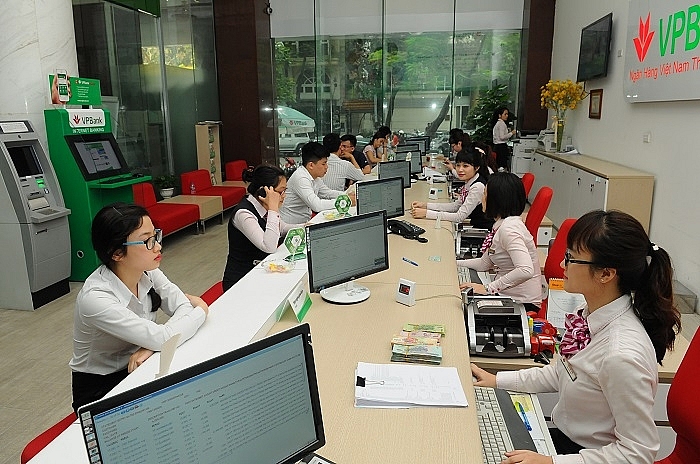Banking sector bad debts under microscope
 |
| VPBank was not doing a smart job with curbing bad debts last year |
Recently-released figures by the National Financial Supervisory Commission showed that the total value of non-performing loans (NPLs) the local banking sector had tacked last year rose by about 30 per cent compared to 2017.
The central bank (SBV) reported that the sector had settled VND149.220 trillion ($6.49 billion) worth of bad debts last year.
Particularly, the NPL ratio on the balance sheet fell to 1.89 per cent by the end of the year from the 2.46 per cent in late 2016 and the 1.99 per cent in late 2017, which is the lowest level since 2012 and is below the regulated level of 2 per cent set by governmental Resolution No.01/ND-CP that was enacted early this year.
Significantly, banks’ latest financial statements showed that last year’s fourth quarter saw a sharp decline in the NPL ratio at many lenders.
| Significantly, banks’ latest financial statements showed that last year’s fourth quarter saw a sharp decline in the NPL ratio at many lenders. |
Statistics show that the total NPLs of 15 banks that have announced their fourth-quarter 2018 financial statements surpassed VND34.810 trillion ($1.5 billion), down 17.7 per cent compared to one year ago.
Accordingly, bad debts (debts classified in groups 3-5 in light of Circular No.02/2013/TT-NHNN of the State Bank of Vietnam) the ratio at Ho Chi Minh City private commercial lender ACB was controlled at 0.8 per cent, helping the bank cut down its provisioning cost by nearly 75 per cent in the fourth quarter last year and 64 per cent in the whole year.
Bad debts on the balance sheet of major state lender Vietcombank hovered at VND6.215 trillion ($270.2 million) by the end of last year, down VND1.209 trillion ($52.6 million) in the last three months alone. Its current bad debts ratio is pegged at 0.98 per cent, one of the lowest in the local banking system.
Sacombank was one of the best performers in tackling bad debts as it succeeded in bringing the ratio from 4.7 per cent in early last year to just 2.11 per cent by the year end, equal to VND5.4 trillion ($234.8 million), down 48 per cent.
The results at small-cap lender Saigonbank were even more impressive as its NPL volume fell by 66 per cent in the fourth quarter last year. For the full year, the NPL volume shed 28 per cent to VND301 billion ($13 million), with the NPL ratio going down to 2.2 per cent by the end of the year from 2.98 per cent in early 2018.
PGBank also succeeded in pulling down its NPL ratio below 3 per cent by the end of last year, from the 4.5 per cent it reported in late September.
However, while many were successful in drastically decreasing their bed debts, others were not so fortunate. For example, at private commercial lender VPBank, consolidated bad debts fell to VND7.766 trillion ($337.7 million) by the end of 2018, down more than VND1.6 trillion ($70 million) compared to last September, but still 25 per cent higher than early last year.
Accordingly, its bad debts ratio rose from 3.38 to 3.51 per cent over the course of the year. The ratio at the parent bank was around 2.7 per cent. The bank still holds over VND3.1 trillion ($134.8 million) in special bonds issued by state-owned Vietnam Asset Management Company (VAMC). Its provisioning cost had, therefore, rose by 40.6 per cent last year to reach VND11.253 trillion ($489.3 million).
The bad debts ratio, pursuant to Circular 02, at state lender Agribank was pegged at 1.51 per cent by the end of last year, which was lower than in late 2017. It reached 104 per cent of its target in tackling bad debts, which touched VND11.936 trillion ($519 million). Last year, Agribank allocated VND25.590 trillion ($1.1 billion) into provisioning costs. According to the bank leadership, with its existing provisioning surplus, the bank is in a position to buy back all the bad debts it has sold to VAMC as well as effectively deal with new bad debts in 2019.
Bad debts at VietinBank rose by VND4.5 trillion ($195 million) by the end of 2018 compared to early last year to hit VND13.5 trillion ($587 million), nearly VND9.5 trillion ($413 million) might be lost.
Bad debts are one of the most important indexes to gauge the health of banks. Until present, five lenders in the banking system have succeeded in tackling bad debt volumes they sold to the VAMC, including Vietcombank, VIB, Techcombank, MBBank, and ACB.
Other lenders such as OCB, Nam A Bank, and Eximbank are scaling up efforts and hope to achieve the target this year.
Financial experts, however, warned that besides tackling their old bad debts, banks must keep a close eye on credit quality to avoid the creation of new bad debts in the system.
What the stars mean:
★ Poor ★ ★ Promising ★★★ Good ★★★★ Very good ★★★★★ Exceptional
Related Contents
Latest News
More News
- Tax sector wraps up 2025 and sets priorities for next year (December 25, 2025 | 14:00)
- A tipping point for digital and hybrid wealth management in Vietnam (December 23, 2025 | 13:33)
- $250 million deal targets women-owned SMEs, sustainable agriculture (December 22, 2025 | 17:40)
- Stock market posts resilient 2025 performance (December 19, 2025 | 18:17)
- Citi Vietnam receives 2025 AmCham CSR recognition (December 19, 2025 | 16:35)
- As global green supply chain reshapes, will Vietnam be left behind? (December 19, 2025 | 08:00)
- Banks gear up for massive capital increases (December 18, 2025 | 17:04)
- Securing capital and efficiency for Vietnam’s 2026-2030 growth ambitions (December 17, 2025 | 10:00)
- Energy sector in need of blended finance mechanisms (December 17, 2025 | 09:00)
- Vietnam still has room to mobilise capital for sustainable growth (December 17, 2025 | 08:57)

 Tag:
Tag:



























 Mobile Version
Mobile Version